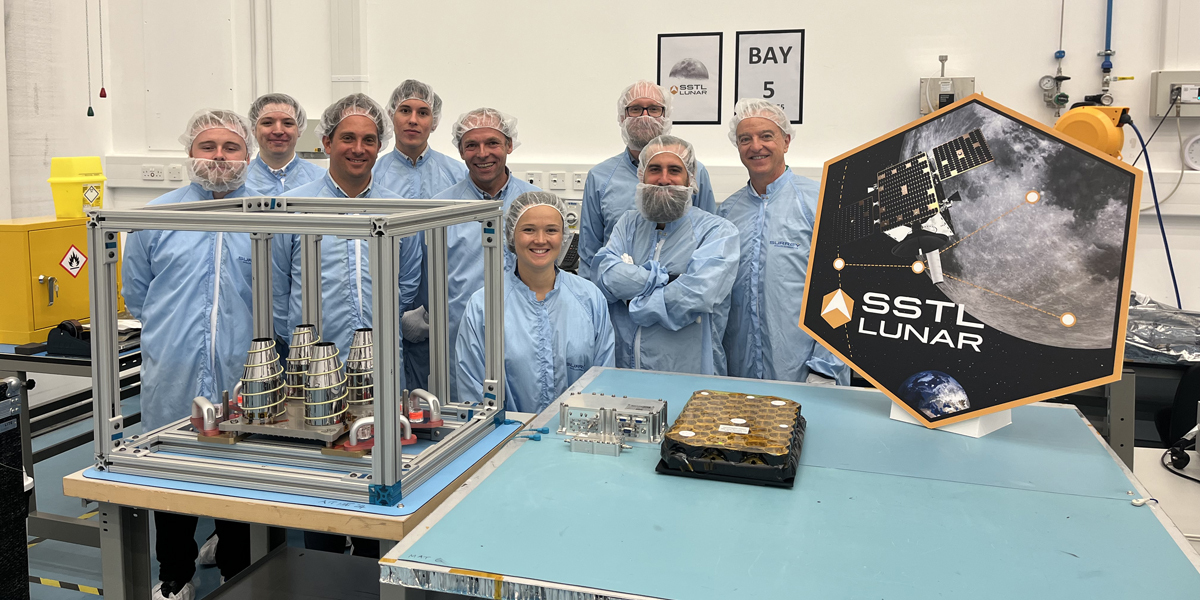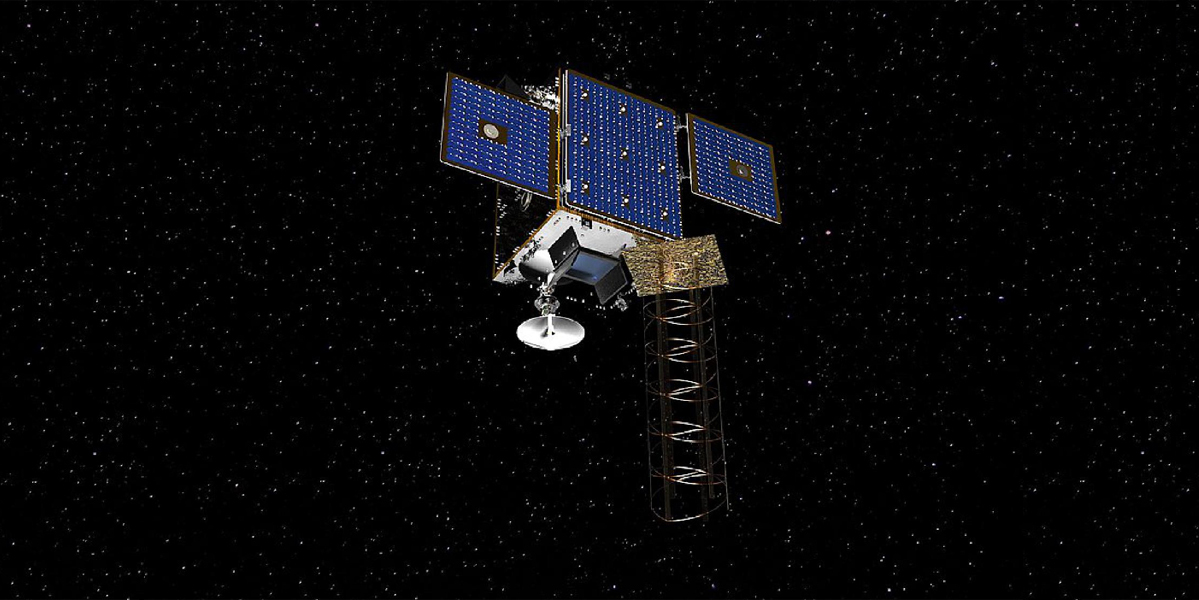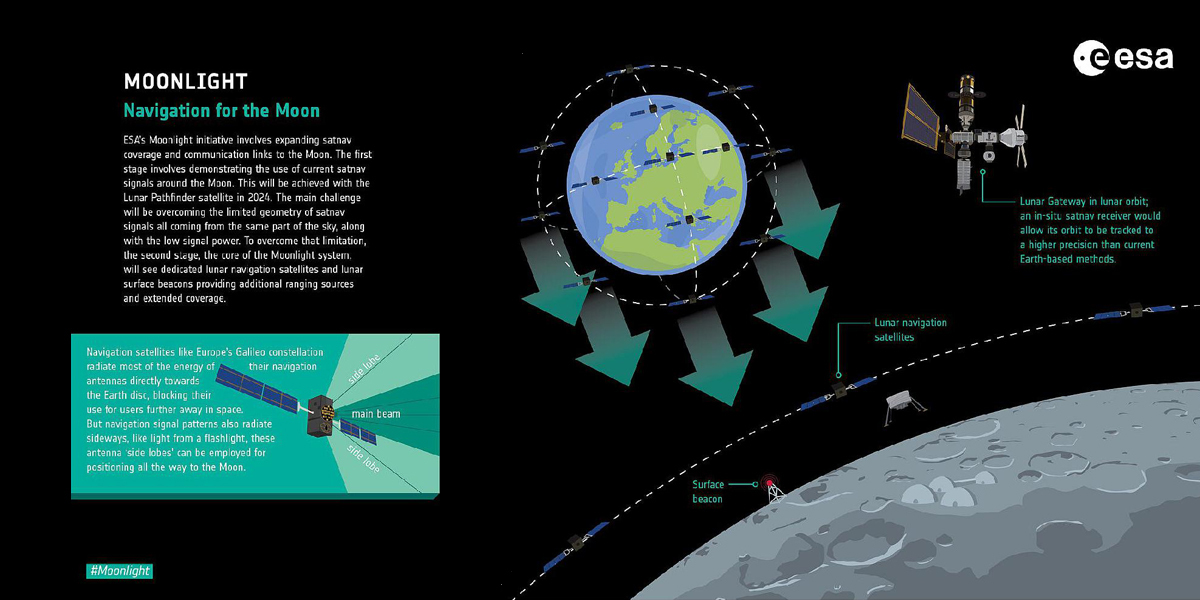The first satnav receiver designed to operate in lunar orbit has been delivered to satellite maker Surrey Satellite Technology Ltd in the UK for integration aboard the Lunar Pathfinder spacecraft.

The complete Navigation payload pictured above includes a four helix antenna (left, in the glass box) developed by MDA in Canada, plus the NaviMoon satnav receiver (middle, on table) from Swiss company SpacePNT, and the low noise amplifier developed by EECL in the UK, who also undertook the manufacturing and the environmental test campaign for both the satnav receiver and amplifier.
The payload is designed to boost and process faint terrestrial Global Navigation Satellite Signal (GNSS) signals from more than 400 000 km away, harnessing advanced processing and navigation algorithms to fix the spacecraft’s position, velocity and timing in lunar orbit in real time. It is complemented by a lunar Laser Retroreflector Array (LRA), developed by NASA under agreement with ESA, composed of 48 mirrored retro-reflectors that will enable centimetre-scale laser ranging of the spacecraft as it orbits the Moon, to authenticate the satnav receiver position fixes during the experiment.
Due to be launched in late 2025, SSTL’s Lunar Pathfinder mission will serve as a telecommunications relay satellite for future missions to the Moon, to serve assets on both the nearside and farside, orbiting in an ‘elliptical lunar frozen orbit’ for prolonged coverage over the South Pole – a particular focus for future exploration. ESA is Lunar Pathfinder’s anchor customer, while NASA will also make use of its services in exchange for delivering Lunar Pathfinder to lunar orbit through its Commercial Lunar Payload Services (CLPS) initiative aboard the CS-3 Firefly Blue Ghost 2 mission.
Lily Forward, SSTL systems engineer and Spacecraft Lead for Lunar Pathfinder, comments: “SSTL is thoroughly looking forward to not only being part of this historic joint venture between ESA and NASA but also being part of the first CLPS task order to fund the transfer of both a landing and orbital asset to the Moon.”
Cyril Botteron, CEO and Co-founder of SpacePNT, says: “This will be for the team the culmination of a long development that we started nearly 10 years ago at Ecole Polytechnique Fédérale de Lausanne (EPFL), with the development of a first proof of concept prototype of a super high sensitivity GNSS receiver suitable for Moon missions.”
Michele Scotti, Technical Manager at SpacePNT, adds: “This achievement stems from the hard work and dedication of the whole team. It is immensely rewarding to have this once-in-a-lifetime opportunity to pioneer autonomous lunar navigation with our NaviMoon receiver.”
Success would mean future Moon missions could effectively navigate in cislunar environment– fixing autonomously and in real-time their position, using GNSS, with an accuracy better than 100 m, while foregoing the use of costly ground infrastructure.
“This may become a practical way for lunar missions to autonomously determine their own orbits, and also to perform time reference transfers between Earth and the Moon,” explains Javier Ventura-Traveset, Moonlight NAV manager leading ESA’s Navigation Science Office and coordinating all ESA lunar navigation activities.
“To validate the satnav results, the Lunar Pathfinder spacecraft will also perform concurrent X-band radio and laser ranging during the GNSS experiment windows. This will allow to test and combine three ranging technologies at once – GNSS, radio and laser ranging – which has never before been performed from lunar orbit.”
Pietro Giordano, Radio Navigation System Engineer and technical officer in charge of the receiver notes that “by demonstrating critical technologies required for precise lunar navigation, our Navigation Experiment Payload has the potential to revolutionize the way satellites are operated in cislunar space”.
A successful formal Delivery Review Board held recently confirmed the payload is ready to be embarked on Lunar Pathfinder.

Lunar Pathfinder is a Commercial Lunar Mission Support Service to provide data services via S-band and UHF links to lunar assets, and an X-band link to Earth (image credit: SSTL)

Infographic: Moonlight - Navigation for the Moon. ESA’s Moonlight initiative involves expanding satnav coverage and communication links to the Moon. The first stage involves demonstrating the use of current satnav signals around the Moon. This will be achieved with the Lunar Pathfinder satellite in 2024. The main challenge will be overcoming the limited geometry of satnav signals all coming from the same part of the sky, along with the low signal power. To overcome that limitation, the second stage, the core of the Moonlight system, will see dedicated lunar navigation satellites and lunar surface beacons providing additional ranging sources and extended coverage (image credit: ESA, K Oldenburg)
Subscribe to our newsletter
Stay updated on the latest technology, innovation product arrivals and exciting offers to your inbox.
Newsletter

